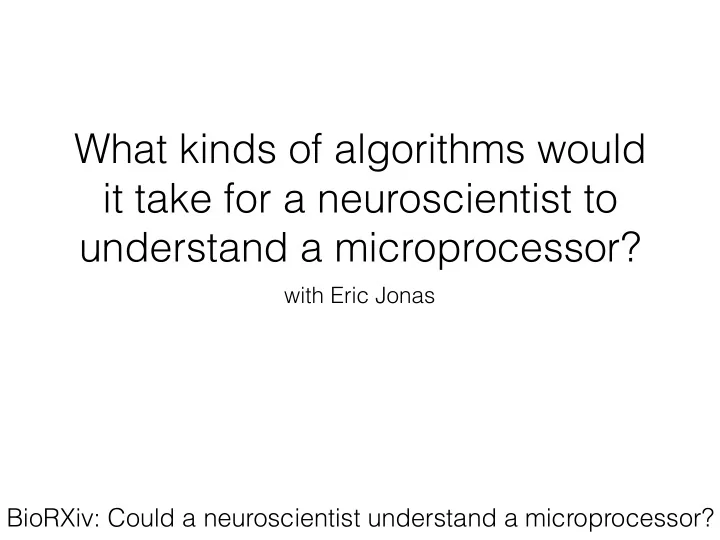

What kinds of algorithms would it take for a neuroscientist to understand a microprocessor? with Eric Jonas BioRXiv: Could a neuroscientist understand a microprocessor?
Error messages are useful
Reverse engineer a big biological distributed algorithm
MOS 6502 Courtesy http://visual6502.org
How it actually works Main Memory Instruction Fetch Memory Interface Control Signals Instruction Decoder Registers Data Signals ALU
Multi scale 1-bit Adder AND gate (silicon) AND gate A Vdd B Vdd VDD+ S Cin VSS A B Cout Out A OUT B logic gate primitives Vss AND XOR OR B A I/V for single gate A B Y A B Y A B Y 0 0 0 0 0 0 0 0 0 VSS- 0 1 1 0 1 1 0 1 0 1 0 1 1 0 1 1 0 0 METAL1 N DIFFUSION 1 1 0 1 1 1 1 1 1 POLY P DIFFUSION CONTACT N-WELL
3 Behaviors
Lesion studies
How to make it work • Problem: Complex game instead of targeted instructions • Same as for brain • But could work if one activated/inactivated • And optimized stimulation so that effects are sparse
“Spike data”
Tuning curves
How to make it work • Problem: not having understanding of “instructions” • Same as for brain • Run lots of programs. Relate instructions to activities.
Strong global correlations
LFPs and power law spectra
Granger causality
How to make these work? • No idea!
Whole chip
Nonnegative matrix factorization finds something
How to make these work? • Need far more different states to be meaningful • Far more data • Nonlinear dimensionality reduction
Souped up Stochastic block model finds some network structure
How to make it work • Problem: The network is far more complicated • Same for the brain • Solutions hierarchical structure inference • MCMC is too slow, clustering too unspecific, needs something in between • Big systems
Kasthuri and Lichtman
0.1 cubic mm 0.1 cubic mm cubic mm 200 microns 200 microns with Kasthuri, Xiao, Jacobsen
Conclusion • We know little about how the brain works • Data by itself won’t solve the problem • Need to ask the fundamental questions • Countless big computational problems
Recommend
More recommend